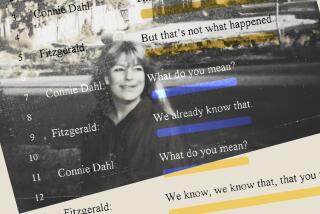Rumor of a Key Witness
- Share via
GLENDORA, Miss. — Johnny B. Thomas grew up with the story of Emmett Till. It filtered down to children here like a dark fable, one that ended with a black boy wrapped in barbed wire at the bottom of a river.
Thomas didn’t see himself as part of that story. Then, when he was 11 or 12, someone told him the old rumor about his father, Henry Lee Loggins.
The summer of 1955, when the 14-year-old Till was murdered for reportedly whistling at a white woman, was also the summer Loggins disappeared. Loggins worked for J.W. Milam, one of the white men who confessed to killing Till. People here have long believed Loggins was present at the crime and spirited out of town so he could not testify at Milam’s murder trial.
For the last 50 years, Loggins has denied knowing anything about the crime. He lived out his life as a junkman in Dayton, Ohio, and, at 82, is recovering from a stroke. In an interview from a nursing home, he said he had never hired a lawyer.
The baby son he left behind -- now 51, the soft-voiced, white-haired mayor of a dying Delta town -- says he fears his father has held back the truth all these years.
Thomas has asked state and federal authorities -- who last year reopened the investigation into Till’s death -- to grant his father immunity from prosecution. Thomas plans to travel to his father’s bedside, perhaps as soon as next week, in a last attempt to settle the matter.
“I feel that toting around that kind of weight serves no purpose but to kill you,” he said. “Get rid of it and you can go ahead and live.”
Told about Thomas’ comments, Loggins repeated what he had said many times, to reporters, to investigators, to his own family: That he knew nothing about the murder.
“I wasn’t there,” he said. “I know people say so, but I wasn’t there. I ain’t that kind of man.”
As the 50th anniversary of the killing approaches, the role played by black men remains a central mystery of the case. Days after the teenager was killed, rumors began circulating that at least two black men had been present -- that they might have held Till down while he struggled to get free or watched helplessly while he was killed.
Hallie Gail Bridges, assistant district attorney for Leflore County, said the FBI had not yet completed its report, so prosecutors had not determined who, if anyone, could be charged in the case. She would not comment on any potential offers of immunity.
“I don’t know where the investigation is going, and I don’t want to step on something that may or may not be in the works,” she said.
Thomas said he had decided to press the matter because the murder affected people beyond Till’s family. Nothing was ever the same, he said, for the black men whose names were drawn into it -- or for the children of those men.
“It was really being sentenced to death to be made to participate, to take a life, to not have your own life,” he said. “I consider my father died twice. He died once when he was made to take this child away. Then he died within himself because he can never do anything about it.”
Till turned heads when he visited his Mississippi cousins. The beloved only son of a Chicago schoolteacher, he was a brassy, citified boy; people noticed right away that he didn’t say “yes, sir” and “no, sir.”
Till had been in Mississippi three days when he made his mistake. He stopped at Roy Bryant’s general store in Money, 20 miles south of Glendora, where he was alone for a moment with Bryant’s young wife, Carolyn. Till’s cousins later testified that they heard him give a wolf whistle.
Three days later, Bryant and his half brother Milam burst into the house where Till was staying. Carrying him to a barn in Drew, west of Glendora, they beat him, shot him, weighed his body down by tying a 75-pound fan from a cotton gin to his neck with barbed wire, and threw him into the Tallahatchie River. When Till’s body was fished out, his face was monstrously distended, with one eye hanging from its socket.
The rumor mill was active in Glendora, where Milam ran a general store that served the black community. Milam and Bryant were arrested the day after the murder. By the start of their trial, two of Milam’s black employees, Loggins and Levi “Too Tight” Collins, had vanished. James Hicks of the Amsterdam News, a black newspaper in New York, reported a week after the trial ended that Collins and Loggins had been locked up in a jail in a neighboring town during the proceedings.
Moses Wright, Till’s uncle, said that when Bryant and Milam burst into his house, a black man stood on the porch, hiding his face. At the trial, a field hand named Willie Reed testified that he had seen the truck carrying Till, and that two black men had been in the back of the truck with the youth. Reed said Till was led into a barn; he later heard screams coming from inside.
Black newspapers and civil-rights figures then urged federal investigators to look more closely at Loggins and Collins. But that never happened. Bryant and Milam were acquitted by an all-white jury. A year later, they confessed to a Look magazine reporter, who paid them $4,000 for the interview.
Speaking from his hospital room, Loggins said he was not present the night Till died. He said that if he had information about the case, “I would tell it, because he was my color.”
Loggins said he had never seen the boy, but he recalled the confidence that made Till -- raised far from the segregated South -- stand out: “All women looked the same to him, because he was from Chicago.”
If he knew how white people in Mississippi were, Loggins said, “he wouldn’t have whistled. He made a mistake because he didn’t know.”
Loggins said that Milam had always treated him fairly and that initially, he could not believe Milam was guilty of murder, “but it turned out he was.” At that time, he said, “it sure was hard to trust white people. I had friends, so-called friends, but they would cut your throat.” He said he moved to the North not because of the Till case, or because his life had been threatened, but “to make more money.”
“I wasn’t the only one who left,” Loggins said. “A whole lot of people left.”
State and federal authorities reopened the investigation last summer, acting in part on new information collected by documentary filmmakers. Most of the central figures are now dead -- Milam died in 1980, and Bryant in 1990. Collins died in 1993. Two people frequently mentioned in connection with the crime are still alive: Carolyn Bryant, 71, who remarried and is living in Greenville, Miss., and Loggins, who had devoted most of his life to his salvage business.
Bridges, the assistant district attorney, said “all the old research puts [Loggins] in it.” She added that prosecutors would take coercion into account when deciding who -- if anyone -- to prosecute.
University of Alabama historian David T. Beito, who has researched the case extensively, said that evidence suggesting Loggins was present was weak, contradictory and largely based on hearsay. Christopher Metress, an English professor at Samford University in Birmingham, Ala., said he had mixed feelings about bringing charges against a man who would have been killed for refusing.
“I see him as a guy caught up in forces really beyond his control, and now I’m afraid we’re going to misjudge him because we don’t fully appreciate the power of those forces,” said Metress, author of “The Lynching of Emmett Till: A Documentary Narrative.”
There is no such hesitation from Simeon Wright, 62, a cousin of Till’s who was sleeping in the room with the youth the night Bryant and Milam took him away.
Loggins “had almost 50 years to come forward,” Wright said. “He didn’t do it. He could have cleared the air, gotten those who were involved while they were alive. As the saying goes, it’s on him now. “I would like to see him talk. And if he doesn’t talk, throw the book at him.”
On a sweltering July afternoon, almost nothing is moving in the town of Glendora. The population has dropped below 300; according to Thomas, the last white resident left in 1994. On the small main street, which was once lined with cafes and clothing shops, vines are creeping in the windows of gutted storefronts. Locusts drone hypnotically. A yellow dog trots across the railroad tracks.
Thomas grew up here without a father. With no stable source of income, Thomas and his siblings had to pick cotton for $1.25 a day, attending school erratically. Thomas, a daydreamer, could never keep up. One of his most vivid childhood memories is his mother, Adeline, beating him on the legs with cotton stalks, prodding him to work faster.
He didn’t blame her. His mother sold corn liquor, did restaurant work and relied on Milam for help.
“Mama had no way to fend for herself,” he said. “My mama was an entrepreneur, and I guarantee that [with a man in the house] we would have risen out of poverty. She was left out there to really just disintegrate.”
Loggins didn’t return to Mississippi until Thomas was 9 years old; he arrived with a gift -- a red bicycle. Every year after that he would make a visit, Thomas said.
Mary Marshall, Thomas’ younger sister, said she also heard the rumors that Loggins was present at Till’s killing. Marshall, 50, who lives in Rochester, N.Y., never saw them as anything but rumors. She had almost forgotten the matter until last year, when she heard that the CBS program “60 Minutes” had interviewed her father.
She hated to see it come back up. The allegations, she said, are something she doesn’t even want to think about.
“He says he didn’t have nothing to do with it,” she said. “I believe my father.”
It was different for Thomas. When prosecutors announced they were reopening the case, Thomas was the first to tell Loggins about it. He offered to act as a go-between when filmmakers asked to interview Loggins. He began pressing old folks in town about what they remembered. Behind it, he said, is the desire to get at the truth, no matter how unsettling.
A full account of what happened will underline “what this country made this innocent, illiterate person do,” Thomas said.
“There was no way he could deny [Milam] anything he was ordered to do -- shoot, cut, break -- whatever,” Thomas said. “There was no way to say no.”
The old folks said they understood. As a black person in Glendora, you got used to seeing things you couldn’t do anything about.
Hester Stevenson, 82, remembers walking into Milam’s corner store one day and seeing Milam beat a black man with a stick. The man’s hands were tied, and there was blood running down his face; terrified, Stevenson backed out of the store and didn’t say anything about it.
A.D. Young, 71, remembers seeing a white man shoot a black gas station attendant on the spot for pumping more gas than he asked for. “Back then,” Young said, “it was easy to come up missing if you said the wrong thing.”
The Till murder fell into this category. Stevenson said she believed Loggins and Collins were present -- against their will -- at the murder, then left town “because they was scared.” Bryant and Milam, she said, “figured them boys was going to tell.”
Young, a former mayor, said that during the trial, everyone in Glendora assumed the two black men were dead. “Wasn’t nobody going to speak of it,” Young said. “We were scared to do anything. And they’re afraid to talk about it up until this day.”
Young said he couldn’t fault Loggins or Collins -- or any black man at that time -- for following Milam’s orders.
“I believe any man in that situation [would have obeyed] if whites told them to, or you’re probably going to end up dead,” he said. “I don’t know of any freedom that we had back then. The law was the white man’s law.”
He added this, though: He said he was glad Milam and Bryant didn’t come to fetch him for a helping hand that night. If they had, he said, they would have had to kill him.
Thomas sometimes feels like he is the last person in the world who wants to live in Glendora.
He’s spent most of his life watching the town die. Roads that were once paved have been allowed to go to gravel. The bridge south of town is closed, sealing Glendora off from nearby communities. A plan to invigorate the economy by seeding sweet potato farms recently collapsed for lack of a market.
Still, for the last year, Thomas has been nursing a vision for Glendora.
His idea has to do with redemption. He’d like to open a civil-rights museum in the town’s old cotton gin, one that stood near Milam’s shop. It may be the place where Milam and Bryant found the heavy fan they used to weigh down Till’s body, he said.
He likes the idea of tourists driving into Glendora to read about its most famous native, the blues musician Sonny Boy Williamson. Then they could learn about the infamous killing -- about Milam, about “Too Tight” Collins, and about the mayor’s father. For this, Thomas needs a more complete account.
So, he’s traveling to Dayton, where father and son can talk face to face.
“I really, really hope he’ll tell the world what happened,” Thomas said. “I think the world will probably forgive him.”
He doesn’t know whether his father will want to tell the story after all these years. Or even, in all honesty, if his father has a story to tell. But he’s crossing his fingers.
More to Read
Sign up for Essential California
The most important California stories and recommendations in your inbox every morning.
You may occasionally receive promotional content from the Los Angeles Times.










